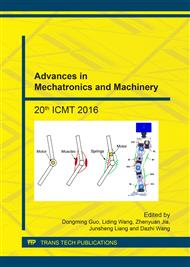[1]
D.A. Winter, Kinematic and kinetic patterns in human gait: variability and compensating effects, J. Human Movement Science. 3(1-2) (1984) 51-76.
DOI: 10.1016/0167-9457(84)90005-8
Google Scholar
[2]
B.L. Webber, C.B. Phillips, N.I. Badler, Simulating Humans: Computer Graphics, Animation and Control, Oxford University Press, New York, (1993).
DOI: 10.1093/oso/9780195073591.001.0001
Google Scholar
[3]
F.C. Anderson, M.G. Pandy, Dynamic optimization of human walking, J. Journal of Biomechanical Engineering. 123 (2001) 381-390.
DOI: 10.1115/1.1392310
Google Scholar
[4]
E.M. Arnold, S.R. Ward, R.L. Lieber, S.L. Delp, A model of the lower limb for analysis of human movement, J. Annals of Biomedical Engineering. 38(2) (2010) 269-279.
DOI: 10.1007/s10439-009-9852-5
Google Scholar
[5]
J. Apkarian, S. Naumann, B. Cairns, A three-dimensional kinematic and dynamic model of the lower limb, J. Journal of Biomechanics. 22(2) (1989) 143-155.
DOI: 10.1016/0021-9290(89)90037-7
Google Scholar
[6]
S. Pejhan, F. Farahmand, M. Parnianpour, Design optimization of an above-knee prosthesis based on the kinematics of gait, C. 30th Annual International Conference of the IEEE Engineering in Medicine and Biology Society. IEEE Engineering in Medicine and Biology Society Conference Proceedings, 2008, pp.4274-4277.
DOI: 10.1109/iembs.2008.4650154
Google Scholar
[7]
M. Costa, A.L. Goldberger, C.K. Peng, Multiscale entropy analysis of complex physiologic time series, J. Physical Review Letters. 89(6) (2002) 8102(1-4).
DOI: 10.1103/physrevlett.89.068102
Google Scholar
[8]
M. Costa, C.K. Peng, A.L. Goldberger, J.M. Hausdorff, Multiscale entropy analysis of human gait dynamics, J. Physica A. 330 (2003) 53-60.
DOI: 10.1016/j.physa.2003.08.022
Google Scholar
[9]
M. Costa, A.L. Goldberger, C.K. Peng, Multiscale entropy analysis of biological signals, J. Physical Review E. 71(2) (2005) 1906(1-18).
Google Scholar
[10]
R. Istenic, P.A. Kaplanis, C.S. Pattichis, D. Zazula, Multiscale entropy-based approach to automated surface EMG classification of neuromuscular disorders, J. Medical & Biological Engineering & Computing. 48 (2010) 773-781.
DOI: 10.1007/s11517-010-0629-7
Google Scholar
[11]
A. Catarino, O. Churches, S.B. Cohen, A. Andrade, H. Ring, A typical EEG complexity in autism spectrum conditions: A multiscale entropy analysis, J. Clinical Neurophysiology. 122 (2011) 2375-2383.
DOI: 10.1016/j.clinph.2011.05.004
Google Scholar
[12]
S.J. McGregor, E. Bollt, Control entropy: What is it and what does it tell us? J. Clinical Kinesiology. 66(1) (2012) 7-12.
Google Scholar
[13]
C. Vimieiro, E. Andrada, H. Witte, M. Pinotti, A computational model for dynamic analysis of the human gait, J. Computer Methods in Biomechanics and Biomedical Engineering. 18(7) (2015) 799-804.
DOI: 10.1080/10255842.2013.848859
Google Scholar
[14]
S.M. Pincus, Approximate entropy as a measure of system complexity, J. Proc Natl Acad Sci USA. 88(6) (1991) 2297-2301.
DOI: 10.1073/pnas.88.6.2297
Google Scholar
[15]
J.S. Richman, J.R. Moorman, Physiological time-series analysis using approximate entropy and sample entropy, J. Heart and Circulatory Physiology. 278(6) (2000) 2039-(2049).
DOI: 10.1152/ajpheart.2000.278.6.h2039
Google Scholar
[16]
S.M. Pincus, Assessing serial irregularity and its implications for health, J. Annals of the New York Academy of Science. 954 (2001), 245-267.
DOI: 10.1111/j.1749-6632.2001.tb02755.x
Google Scholar
[17]
A.L. Goldberger, C.K. Peng, L.A. Lipsitz, What is physiologic complexity and how does it change with aging and disease? J. Neurobiology of Aging. 23 (2002) 23-26.
DOI: 10.1016/s0197-4580(01)00266-4
Google Scholar


